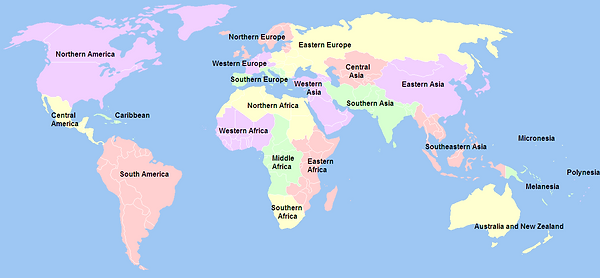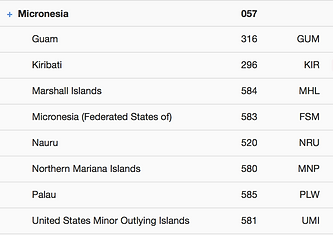Definitions of "Oceania"
As mentioned before, the term Oceania has multiple meanings. The most relevant and widely recognised definitions of Oceania are probably the ones made by the United Nations and its different bodies and agencies. However, it seemed interesting to also include the definitions of the term that other international organisations work with. Here is our complete analysis.
GEOGRAPHICAL AND GEOPOLITICAL CONCEPTIONS
Oceania in the United Nations Geoscheme
The United Nations Geoscheme is a system defined by the United Nations Statistics Division (UNSD) which divides the countries of the world into regions and subregions. Such division is purely made for UNSD’s “statistical convenience”, with the aim of obtaining accuracy in its publications and databases. Geographic regions and subregions are said to be based on continental regions.

United Nations Geoscheme. Source: Wikipedia
Oceania is recognized by the UNSD as a region, which in turn is divided into 4 subregions: Australia and New Zealand, Melanesia, Micronesia and Polynesia. The list of countries and dependencies in each subregion is presented below.




Source: United Nations Statistics Division
Oceania in the United Nations Regional Groups
The United Nations Regional Groups are geopolitical regional groups of UN Member States defined by the UN’s Department for General Assembly and Conference Management. The main function of the Regional Groups division is to distribute membership quotas in United Nations bodies and leadership positions. Bodies such as ECOSOC and UNHRC, as well as the non-permanent members of the UN Security Council, have set their own membership quotas for each regional group.
According to this division, Oceania is part of the Asia-Pacific Group. The Asia-Pacific group has 53 member States (27.5% of all UN members), being the second largest regional group by number of Member States. It represents a population of 4.24 billion people, that is, 58.5% of UN members population. Its territory is composed of much of the continents of Asia and Oceania with some exceptions, such as Australia and New Zealand, which are part of the Western European and Other Groups regional group. As for the membership in UN bodies, the Asia-Pacific group has 3 seats in the UNSC (including China as one of the five UNSC permanent members), 11 in ECOSOC and 13 in UNHRC.

However, in 2000, the government of the Republic of Nauru proposed a new Pacific regional group to be formed under the name of Oceania. The group would include Australia, New Zealand, Japan, South Korea, the ASEAN countries and the rest of Oceania. As mentioned in the Statement by H.E. Vinci N. Clodumar, the Pacific demands “special attention”; it has its particular vulnerabilities and therefore faces particular socio-economic and environmental challenges. Such challenges include the protection of the oceans (as it is the main resource of most Pacific Islands), fishing, global warming and the rise of sea levels (threatening the low-lying Pacific Islands), disarmament, and poverty.
The report indicates that the Economics and Social Commission for Asia and the Pacific (ESCAP) estimates the Pacific to grow only 2% in the next 3 years, while the rest of Asia is estimated to grow 6%.
According to the government of Nauru, the Asia-Pacific group seemed reasonable years ago. However, and with the progressive inclusion of a larger number of Pacific Islands, the current 11 Pacific Islands are now “drowning in the Asian group”. In Nauru’s view, the new grouping would represent more equitably the Pacific Islands in the UN.
UN Security Council and General Assembly membership quotas by regional group. Source: Wikipedia
SOCIO-ECONOMIC CONCEPTIONS
Oceania and the United Nations Organization for Education, Science and Culture (UNESCO)
UNESCO: The United Nations Organization for Education, Science and Culture (UNESCO) includes Oceanian countries in the “Asia and the Pacific” region. UNESCO indicates that this region may not “forcibly reflect geography”; such division refers, instead, to a regional area of activities carried out by the organization.
Oceania and the the United Nations Economic and Social Council (ECOSOC)
The United Nations Economic and Social Council (ECOSOC) is one of the main six organs of the United Nations, and coordinates five regional commissions working in economic and social fields around the world. The Economic and Social Commission for Asia and the Pacific (ESCAP) is one of these five regional commissions, and is made up of 53 Member States of the Asia-Pacific group. The ESCAP has 4 subregional offices, one of which is the Subregional Office for the Pacific; however, Oceania does not have an office of its own.
The ESCAP Subregional Office for the Pacific covers the territories of Fiji, Kiribati, Marshall Islands, Micronesia (Federated States of), Nauru, Palau, Papua New Guinea, Samoa, Solomon Islands, Tonga, Tuvalu and Vanuatu, as well as American Samoa, the Cook Islands, French Polynesia, Guam, New Caledonia, Niue and the Northern Mariana Islands as associate members.

ESCAP territories. Source: United Nations Regional Commissions New York Office
Oceania and the World Bank
Granted an observer status at the United Nations, the World Bank is an international organisation that has two goals: a) to end poverty and b) to promote shared prosperity in a sustainable way. The World Bank sets two divisions, “Regions” on one hand and “Country Groups” on the other. When it comes to “Regions”, most of Oceanian countries are represented in the “East Asia and Pacific” region, which includes Papua New Guinea and 11 Pacific Islands. However, as for the “Country Groups” division, only the 11 Pacific Islands, but not Papua New Guinea, are included in the “Pacific Islands” group.
BIOGEOGRAPHICAL AND ENVIRONMENTAL CONCEPTIONS
World Wildlife Fund for Nature (WWF)’s Oceanian realm or ecozone:
Although there are multiple ways to classify the biodiversity of the planet, WWF biologists have set a scheme that divides the world’s land area into 7 biogeographical realms or ecozones (8 if the Antarctic is also included). These are the broadest biogeographical units, which are in turn subdivided into different, smaller ecoregions. WWF defines an ecoregion as a "large unit of land or water containing a geographically distinct assemblage of species, natural communities, and environmental conditions". Each ecoregion is characterised by a main biome or major habitat type; and WWF distinguishes 26 of them, whether they are terrestrial, freshwater or marine.
Oceanian countries make up 2 of the 7 ecozones: the Oceanian realm (which includes Micronesian islands, Fiji, Hawaiian Islands and Polynesia) and the Australasian realm (which includes Australia, New Zealand, most of Melanesia including New Guinea, Vanuatu, Solomon Islands and New Caledonia).
IUCN’s Oceania region
The International Union for Conservation of Nature (IUCN) is an international organisation whose aim is to promote the conservation of nature and the sustainable use of natural resources. Oceania is regarded as a IUCN region on its own, and its programme is one of the largest ones carried out by the organisation, as it covers around 100 million km2 of the Pacific Ocean. IUCN’s Oceania region covers Australia, New Zealand and other 22 countries and territories of the Pacific Islands that are part of Melanesia, Micronesia and Polynesia.